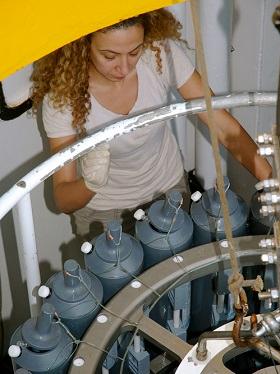The state of smart cities in MENA
11 December 2025
Published online 17 September 2013

Enzymes isolated from hardy bacteria in the underwater brine pools of the Red Sea could be effective as agents that degrade industrial pollutants and toxic chemicals, researchers believe.
With temperatures of up to 70°C, saline levels more than seven times that of normal seawater, high concentrations of heavy metals, and an absence of oxygen, these brine pools are hostile to most life forms.
They have not been the subject of extensive research, but the limited studies that have been undertaken suggest that they are teeming with a wide variety of extremophile micro-organisms, which produce some unique enzymes1.
Rania Siam of the American University of Cairo (AUC) is characterising the adaptations that enable these microbial communities to thrive in harsh conditions.
A large collaborative project, being carried out in conjunction with researchers from the King Abdullah University of Science and Technology (KAUST) in Thuwal, Saudi Arabia, has already led to the identification of several distinct strains of extremophile bacteria2.
Isolating microbes from such extreme environments is difficult, so Siam and her colleagues used a slightly different method to identify the new enzymes. "We utilized environmental genomics," she explains. "Instead of isolating a single microbe, we isolate the genomic material in the environment and analyse it."
Using this approach, Siam and her colleagues have identified two novel enzymes, found in water samples taken from the Atlantis II brine pool in the Red Sea, and have submitted provisional patents for both of them.
One is an esterase, which splits esters, a class of organic compounds, into an acid and an alcohol molecule. This hydrolysis reaction breaks the chemical bonds in the esters by the addition of a water molecule.
The esterase is the first enzyme isolated from such an extreme environment, Siam says. It is active under such high salinity and temperature in toxic concentrations of a diverse spectrum of heavy metals, meaning it has several applications. Siam lists its uses as "degradation of natural materials, industrial pollutants and toxic chemicals," and says it may also be used in the paper and detergent industries.
The second enzyme also has potential uses in the removal of pollutants. Studies led by Hamza El-Dorry and Ahmed Abdelaziz, Siam's colleagues at AUC, show that it can detoxify a certain metal under much harsher conditions than any other enzyme isolated so far.
"Similarly, this enzyme is active under higher salinity, higher temperature and much higher concentration of this particular heavy metal than any other enzyme isolated from the same family," she says.
Siam's research group is trying to isolate and characterise other heavy metal-resistant enzymes from Red Sea brine pools. They want to understand the function of novel genetic sequences from different sites.
doi:10.1038/nmiddleeast.2013.157
Stay connected: